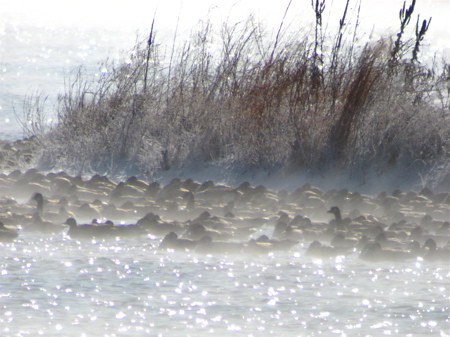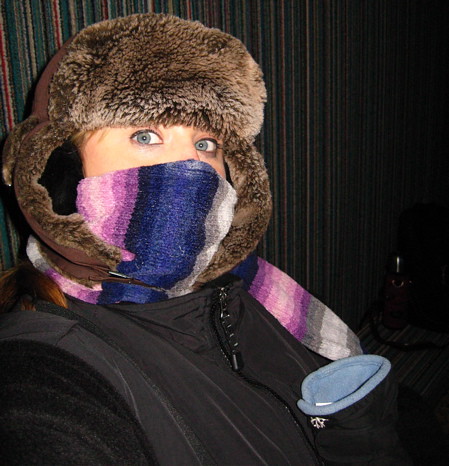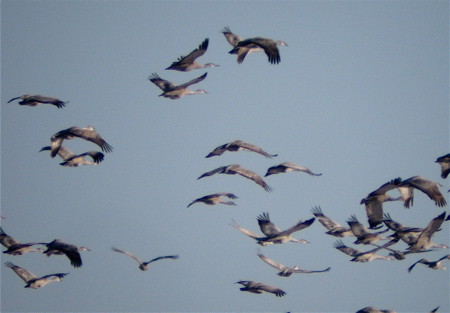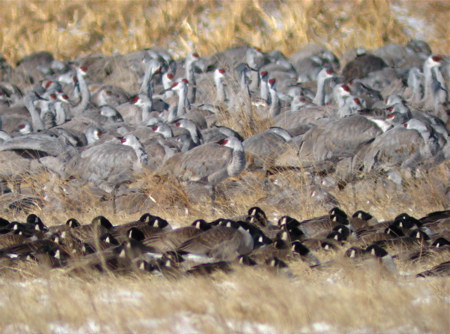The photos in this blog entry are from Stan Tekiela and Amber Burnette.
 This year's trip to Nebraska was just chock full of "Holy Crap" moments. I mean, the common crane (in the above photo) that we saw within thirty minutes of arrival to the area after driving all day was almost too much to hope for. I just found out that it's on the American Birding Association Blog and is classified as a Code 4 Bird (Casual--Species not recorded annually in the ABA Checklist Area, but with six or more total records—including three or more in the past 30 years—reflecting some pattern of occurrence). As a field trip leader you kind of wonder how you will top a sighting like that for the rest of the weekend--but top it, we did!
This year's trip to Nebraska was just chock full of "Holy Crap" moments. I mean, the common crane (in the above photo) that we saw within thirty minutes of arrival to the area after driving all day was almost too much to hope for. I just found out that it's on the American Birding Association Blog and is classified as a Code 4 Bird (Casual--Species not recorded annually in the ABA Checklist Area, but with six or more total records—including three or more in the past 30 years—reflecting some pattern of occurrence). As a field trip leader you kind of wonder how you will top a sighting like that for the rest of the weekend--but top it, we did!
The following documented behavior is the type of stuff that a girl like me reads about in magazines and wonders if I'll ever have a chance to witness in real life. Again, I want to thank Stan and Amber for letting me use their photos in the blog to share it with you. Click on the photos if you wish to see the larger version.
We were watching a group of cranes forage in a field when we noticed something was spooking them and causing them to fly off. I was in the bus with half the group and Amber and Stan were outside with the rest getting shots of cranes in flight.
 That's when we all noticed an adult bald eagle in hot pursuit of one of the cranes. Somehow the eagle had managed to get one crane separated from the flock. I started shouting, "It's going for the crane, it's going for the crane, it's going for the crane!" I wondered if the others outside the bus noticed, but Amber's enthusiastic yelling told me they had. Everyone was shouting on the bus, it was like an intense football game but the crowd was unsure of which team to root for--we all loved eagles and we all loved cranes (I think it's a safe assumption that for Raptor Center alums like Amber and me--we were on Team Eagle).
That's when we all noticed an adult bald eagle in hot pursuit of one of the cranes. Somehow the eagle had managed to get one crane separated from the flock. I started shouting, "It's going for the crane, it's going for the crane, it's going for the crane!" I wondered if the others outside the bus noticed, but Amber's enthusiastic yelling told me they had. Everyone was shouting on the bus, it was like an intense football game but the crowd was unsure of which team to root for--we all loved eagles and we all loved cranes (I think it's a safe assumption that for Raptor Center alums like Amber and me--we were on Team Eagle).
 The bald eagle closed the gap in such a short amount of time, it pumped its wings hard and was soon on top of the crane. It flew past the crane just a little, dove at it and missed.
The bald eagle closed the gap in such a short amount of time, it pumped its wings hard and was soon on top of the crane. It flew past the crane just a little, dove at it and missed. Here is the eagle making a second attack.
Here is the eagle making a second attack. The sandhill crane breaks free and starts to drop.
The sandhill crane breaks free and starts to drop.
 The eagle makes a quick grab a second time.
The eagle makes a quick grab a second time.
 The eagle has the crane in its talsons and is flying while carrying the crane upside down, wings open!
The eagle has the crane in its talsons and is flying while carrying the crane upside down, wings open!
 The bald eagle is holding the sandhill crane for one or two seconds before...
The bald eagle is holding the sandhill crane for one or two seconds before...
 The eagle lost its grip and the crane starts to fly away with the eagle coming after it.
The eagle lost its grip and the crane starts to fly away with the eagle coming after it. The eagle gives one last chase before breaking off from the crane. What was interesting to me was that the crane and the eagle ended up flying right over our bus. As the crane flew over, the eagle appeared to slow and change direction. I'm left with so many questions from this encounter. Did the eagle not want to fly over humans? Did the crane luck out or fly over us on purpose? We did not see where either bird ended up, but did the eagle make a wide circle and wait out the exhausted crane? Did the crane fly away in its weakened state and become coyote chow? How deep did the talons get?
The eagle gives one last chase before breaking off from the crane. What was interesting to me was that the crane and the eagle ended up flying right over our bus. As the crane flew over, the eagle appeared to slow and change direction. I'm left with so many questions from this encounter. Did the eagle not want to fly over humans? Did the crane luck out or fly over us on purpose? We did not see where either bird ended up, but did the eagle make a wide circle and wait out the exhausted crane? Did the crane fly away in its weakened state and become coyote chow? How deep did the talons get?
 Out of all the sandhill cranes that took off, why that one bird? Did the eagle see something different or was it just that the crane foolishly went away from the safety of the flock? This was an adult eagle--has it killed a crane successfully before?
Out of all the sandhill cranes that took off, why that one bird? Did the eagle see something different or was it just that the crane foolishly went away from the safety of the flock? This was an adult eagle--has it killed a crane successfully before?
Such a cool encounter and yet so many questions unanswered.









